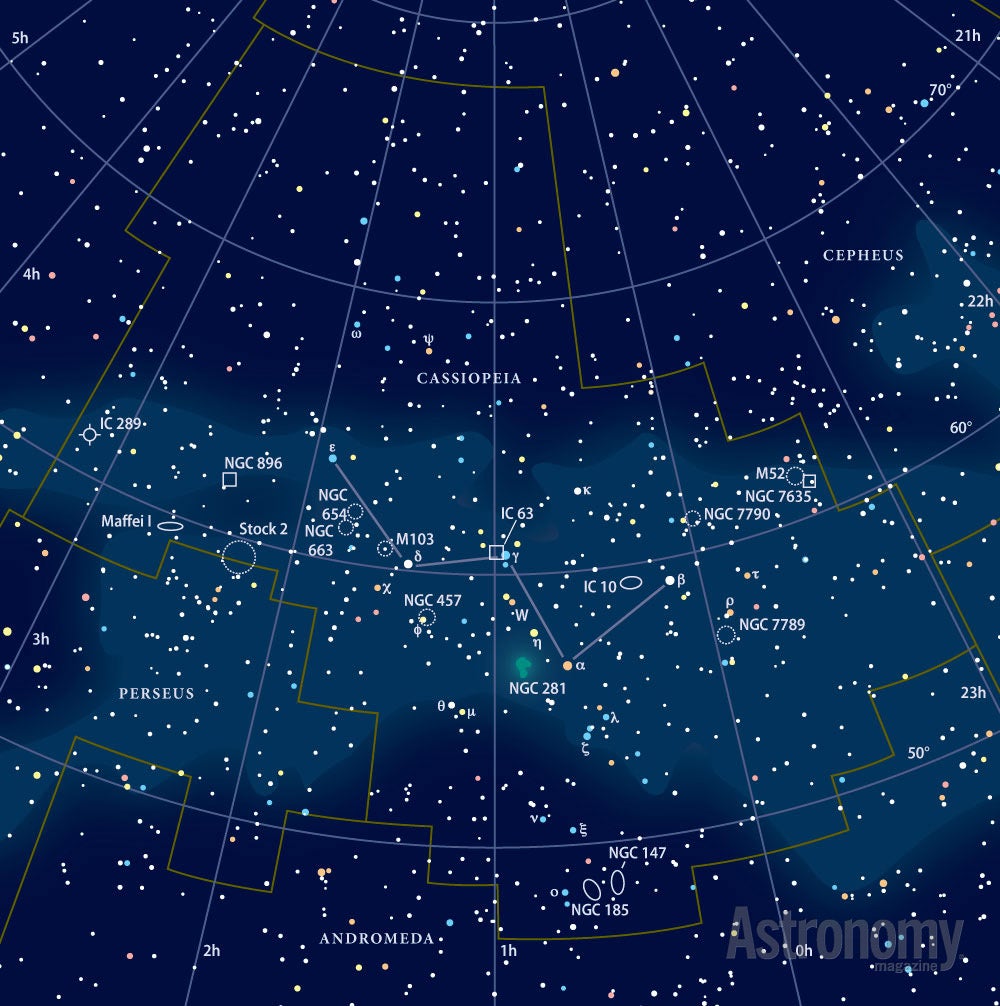Targets for September 17–24, 2015
Small telescope: Open cluster NGC 7790
Large telescope: The Cave Nebula (Sharples 2–155)
Large telescope: Spiral galaxy NGC 7184
Open for business
This week’s small-telescope target is open cluster NGC 7790 in the constellation Cassiopeia. You’ll find it 2.5° northwest of magnitude 2.3 Caph (Beta [β] Cassiopeiae). Although you can see this magnitude 8.5 cluster through binoculars, you’ll need at least a 4-inch scope to resolve it well. It spans 17′, which means it covers an area 30 percent as large as the Full Moon.
You’ll easily spot several dozen stars. The background stars here are dense, but the cluster stands out nicely. Two other open clusters flank NGC 7790: Magnitude 9.4 NGC 7788 lies 17′ to the northwest, and magnitude 9.7 Berkeley 58 sits 20′ to the southeast.
Celestial spelunkers take note
This week’s first large-scope object is the Cave Nebula, also known as emission nebula Sharpless 2–155 and Caldwell 9. It lies in the constellation Cepheus the King.
Look for this nebula 3.7° south-southeast of magnitude 3.5 Iota (ι) Cephei. To be honest, Sh 2–155 is a better target for astroimagers than for visual observers, but it’s so famous that you should certainly take a peek at it at least once. A telescope with an aperture of 16 inches or more equipped with a nebula filter will bring it in for you.
The Cave Nebula isn’t small. It measures 50′ by 30′ — almost twice the size of the Full Moon. Look carefully for the deep, dark indentation in the nebulosity.
The nebula’s moniker arises from the wide, dark region easily visible on images. The dark nebulosity appears like the mouth of a cave, thus the common name of Sh 2–155.
Not quite the Fab Four
This week’s second large-telescope target is spiral galaxy NGC 7184. It glows at magnitude 10.9 and measures 6.5′ by 1.4′.
This target sits in a desolate region of southwestern Aquarius near that constellation’s border with Capricornus. To star-hop to its location, find 6th-magnitude 41 Aquarii and move 2.7° west.
The spiral’s long axis tilts roughly northeast to southwest. It appears to point to a 12th-magnitude star just off its northeast end, but of course that star lies much closer to us. Through most scopes, NGC 7184 appears 4 times as long as it is wide.
If you observe NGC 7184 through a 12-inch or larger telescope, you’ll spot a faint trio of galaxies in an ever-so-slightly curved line. Spiral NGC 7180 (magnitude 12.6), elliptical NGC 7185 (magnitude 12.2), and spiral NGC 7188 (magnitude 13.2) lie 17′, 21′, and 32′ north, respectively.
Expand your observing at Astronomy.com
StarDome
Check out Astronomy.com’s interactive StarDome to see an accurate map of your sky. This tool will help you locate this week’s targets.
The Sky this Week
Get a daily digest of celestial events coming soon to a sky near you.
Observing Basics
Find more guidance from Senior Editor Michael E. Bakich with his Observing Basics video series.











